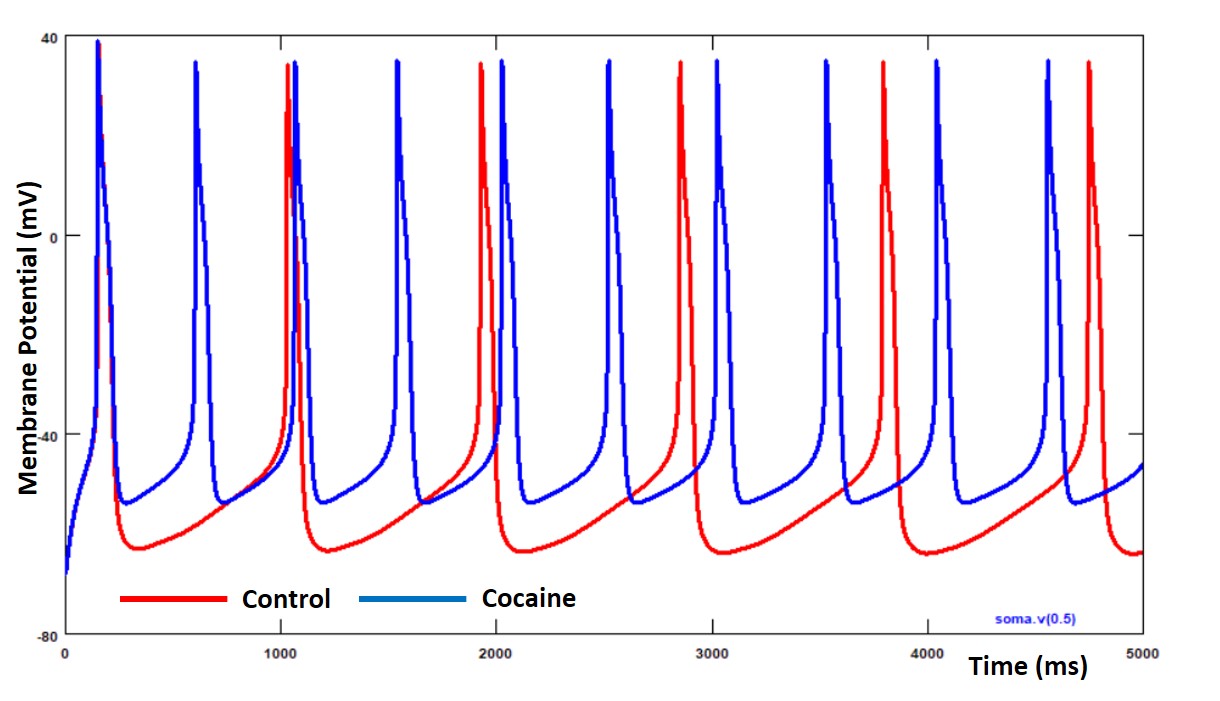Objective: The neurological reason behind the loss of dopamine neurons causing Parkinson’s disease (PD) is an unsolved mystery.
Background: As PD is identified as a classic disorder of “brain arrhythmias”, several pharmacological targets are under clinical trial to rejuvenate neurons for evoking normal firing patterns. With experimental evidence, this in silico study investigates action potential (AP) oscillation patterns of dopamine neurons towards cocaine exposure.
Method: This single compartmental in silico model comprises the inward rectifier ion channels, voltage-gated sodium channel, voltage-gated potassium channel, L-type calcium channel, large-conductance calcium-dependent potassium (BK) channel, small conductance calcium-dependent potassium (SK) channel, and calcium diffusion mechanisms. All ion channels are expressed by the conventional Hodgkin-Huxley formalism. Cocaine exposure (1mg/kg to 10mg/kg) profile is reflected as the conductance of SK channel is mimicked by changing the maximum conductance of SK channel in dopamine neuron.
Results: After injecting a current stimulus (Istim) of varying magnitude (0.1-0.6nA) and duration (1-5ms), APs are reproduced by the whole-cell model. The modulating effects of cocaine exposure on dopamine neurons’ electrophysiological properties are investigated in two folds. First, we simulated the current-voltage profile of the SK ion channel with respect to multiple doses of cocaine under the voltage clamp protocol. It showed the continuous decrease of outward current because of multiple doses of cocaine from 1mg/kg to 10mg/kg. Then, the altered SK ion channel outward current is incorporated into the whole-cell model to investigate the AP firing patterns. Figure 1 shows the elevation of AP oscillation (Blue solid line) because of cocaine dose of 10mg/kg with respect to control AP firing patterns (Red solid line).
Conclusion: Cocaine works on a membrane receptor pathway to inhibit the extracellular calcium entry into the cell. As a result, a few SK ion channels are activated across the membrane and it reduces the whole-cell outward current. The reduced outward current elevates the cell’s excitability for AP generation. Our in-silico study interprets a sub-cellular mechanism linking cocaine-evoked altered ion channel activity to neuronal firing patterns, shedding light on novel pharmacological targets for PD.
To cite this abstract in AMA style:
CHI. Mahapatra. In Silico Study Reveals Cocaine Exposure Modulates Dopamine Neuron Firing Patterns by Inhibiting Small Conductance Calcium Activated Potassium Current [abstract]. Mov Disord. 2022; 37 (suppl 2). https://www.mdsabstracts.org/abstract/in-silico-study-reveals-cocaine-exposure-modulates-dopamine-neuron-firing-patterns-by-inhibiting-small-conductance-calcium-activated-potassium-current/. Accessed December 20, 2025.« Back to 2022 International Congress
MDS Abstracts - https://www.mdsabstracts.org/abstract/in-silico-study-reveals-cocaine-exposure-modulates-dopamine-neuron-firing-patterns-by-inhibiting-small-conductance-calcium-activated-potassium-current/

